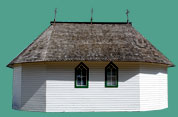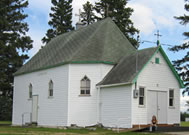St. Elijah Romanian Orthodox Pioneer Church
Historic Photographs and Documents
Below you will see historical photographs related to the St. Elijah Pioneer Church. They include:
- St. John the Baptist Church (c. 1920)
- Lennard Church and Belfry (1929)
- Historic Group Photos: Dedication Day (1908) & Morusca Visit (1936)
- Fr. Marioncu's funeral, November 5, 2009 (photos)
- Documents witnessing the transfer of land from John Paulencu to St. Elijah Romanian Orthodox Church, 1911 (document with transcription)
The St. Elijah Pioneer Museum thanks all those who have contributed these materials. We would also request that anyone who may have additional photographic records or other documents and information related to the Pioneer Church to please contact us at .
Photographs
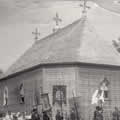
- Tour photo link
- Tour photo link
- Tour photo link
- Tour photo link
- Tour photo link
- Tour photo link
- Tour photo link
- Tour photo link
- Tour photo link
- Tour photo link
- Tour photo link
- Tour photo link
These two picture of St. John the Baptist Romanian Orthdox Church of Shell Valley, Manitoba (about 7 miles north of St. Elijah Church in Lennard), were probably taken in the early nineteen twenties, shortly after the church was contructed in 1919. It may have been taken on the first "Hram". Notice the early the presence of automobiles, five are visible in the photograph, as well as the freshly cleared land, and the traditional peasant clothing styles, mostly worn by the women, which contrasts with the Western fashions worn by the men.
See contemporary photos of St. John the Baptist Romanian Orthodox Church. If you can identify any of the people in this photo, please do not hesitate to contact us and we will add this information to the photo captions.
From the collection of William Holovach, digitized by Greg Holovach.
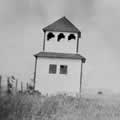
Lennard Church and Belfry, 1929 [click to view photo]
This picture of St. Elijah pioneer church taken in August 1929 has two striking features.
We see the wooden belfry which once stood with the church. The belfry was built away from the church as a separate structure, an architectural tradition found in Romanian churches dating back to the 1600s: example 1 | example 2). St. John the Baptist Romanian Orthodox Church of Shell Vally Manitoba also has a separate bell tower. The St. Elijah belfry still stands in the yard of the Blue Wing Romanian Orthodox church in Blue Wing, Manitoba, 15 km away, where it was moved after the new St. Elijah church was built in 1952.
In this photo, the pioneer church was located close to where the active St. Elijah church is now located. When the new church was completed, the pioneer church was moved away to one corner of the church yard where it remained until it was moved to its present site and restored. The fence in the photo, just west of the bell tower, was where the boundary between the Burla and Paulencu homesteads would have been located (see Land Transfer documents below).
From the collection of Annie Slusarchuk, digitized by Karen Funk.
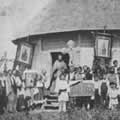
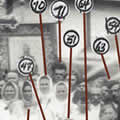
Historic Group Photos: Dedication Day (1908) & Morusca Visit (1936) [click to explore the photos]
- Pioneer Church historic photo link
- Pioneer Church historic photo link
- Pioneer Church historic photo link
- Pioneer Church historic photo link
- Pioneer Church historic photo link
- Pioneer Church historic photo link
- Pioneer Church historic photo link
- Pioneer Church historic photo link
- Pioneer Church historic photo link
- Pioneer Church historic photo link
- Pioneer Church historic photo link
- Pioneer Church historic photo link
- Pioneer Church historic photo link
- Pioneer Church historic photo link
- Pioneer Church historic photo link
- Pioneer Church historic photo link
- Pioneer Church historic photo link
- Pioneer Church historic photo link
- Pioneer Church historic photo link
- Pioneer Church historic photo link
In this gallery you will find two group photos taken in front of the St. Elijah Pioneer Church: the first on dedication day, shortly after the church was completed; the second on the visit of Rt. Rev. Bishop Policarp Morusca to Lennard, Manitoba on June 7th 1936, shortly before Ukrainian members built a separate orthodox church less than a kilometer up the road.
You will find the names of seventy-one of the people in the Morusca Visit photo below. These people are identified in the photo gallery as well. The key was created by ? in 19??. In addition, there are photographic inserts identifying religious icons in the photos which are today are still part of the Museum's collection.
The dedication day photograph was donated to the Museum by George Iftody in 1980.
Names of people identified in the Morusca Visit photo: (note: this is the key for the numbers on the pictures in the photo gallery)
1. George Mintenko; 2. Peter Hlopina; 3. Nihalki Gorda; 4. Grigore Goruliuk; 5. John Brenzen; 6. Ioana Bezniar; 7. Louis Besniar; 8. Nestor Holunga; 9. Bill Stolarchuk; 10. Mrs Buleziuk; 11. no name; 12. no name; 13. Mrs Mary Chewka; 14. Vera Ungrin Washniuk; 15. no name; 16. Helen Washniuk; 17. Bill Flundra; 18. George Goods; 19. Mary Buleziuk Holovach; 20. Olivia Washniuk Coumo; 21. George Ungrin; 22. Mrs Kozma Bezan ?; 23. Sam Ungrin; 24. no name; 25. Fred Gorda; 26. Leontina Hlopina; 27. Lena Bezan Gabor; 28. Mary Burla; 29. Lena Goraliuk; 30. Sam Sarafinshin; 31. John Titian; 32. Nick Burla; 33. Peter Gabor; 34. John Washniuk; 35. Elsie Ursulak; 36. Doreen Gorda; 37. Dora Pentlichuk Poclitar; 38. Alex Titian; 39. Sadie Chescu Kobliuk; 40. George Gabor; 41. George Burla; 42. Elsie Paulencu Popescu; 43. Louis Mintenko; 44. Elsie Ungrin Sodaway; 45. John Paulencu; 46. Eli Burla; 47. Pentelai Holovach; 48. Jim Kobliuk; 49. Eli Paulenko; 50. Jim Martin; 51. Nestor Onofreichuk; 52. Mrs Louis Mintenko; 53. Ted Paulencu; 54. Denis (Tanase) Chewka; 55. Johnny Poclitar; 56. Ganza Romanowich Paulencu; 57. Victoria Paulencu Goroluik; 58. Lena german Paulencu; 59. George Mintenko; 60. John Nevistiuk; 61. Nick Semeniuk; 62. Vasily Burlaku; 63. Vasily Holunga; 64. Nicolai Holovach; 65. Ann Gabor; 66. Barbara Paulencu; 67. Ina Paulencu Starchuk; 68. Ted Sodaway; 69. Sam Holovach; 70. Agrapina Gabor; 71. Jack Goraluik
Hi res version of Dedication Day (1908) photo for download (1.4 megs).
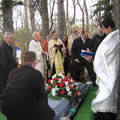
Fr. Marioncu's funeral, November 5, 2009 [click to see photos]
On November 5, 2009, former parish priest at St. Elijah in Lennard, MB, Fr. Nicolai Marioncu, was buried in his chosen spot beside the church where he had served for 11 years, next to Fr. Glicherie Popa who had been the parish priest at St. Elijah for 22 years, from 1934 to 1956. Fr. Popa was the longest serving priest in the history of the parish.
The funeral service for Fr. Marioncu was conducted by seven priests and deacons, and Archbishop Nathaniel of the Romanian Orthodox Episcopate of America in Jackson, Michigan.
Fr. Marioncu was born in Banat, Yugoslavia in 1927 and graduated from St.. Sava Theological Seminary in Belgrade in 1949. As a young priest, he served in several parishes in Yugoslavia for 16 years before he moved to USA and assumed duties at parishes in Worchester, Mass., Hollywood, Florida and Woodsocket, R.I. In 1978 he was assigned to St. Elijah in Lennard and also served St. John the Baptist Church in Shell Valley and Holy Trinity Church in McNutt, SK. for 11 years. In 1989 he became Dean of the Romanian Orthodox Churches of Canada for four years while living at Fort Qu'appelle, SK. After retiring in 1992, Fr. Marioncu returned to the Lennard area and resided in Russell until his death.
Documents
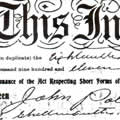
Indenture and Deed of Land (with text transcription) Witnessing the transfer of land from John Polanki (Paulencu) to the Orthodox Romanian Greek Church (St. Elijah Romanian Orthodox Church, Lennard Manitoba), 1911. 12 pages. – [click to view PDF]
John and Mary Paulencu, and Eli Burla each gave their community adjoining pieces of their quarter sections of land near Lennard, Manitoba to provide a place to build a Church and establish a cemetery. This is where, today, the St. Elijah (St. Eli) Romanian Orthodox Church and Cemetery, as well as the St. Elijah Pioneer Museum and Cemetery are found.
These two documents, The Indenture and Deed of Land for the Paulencu's contribution, were drawn up and witnessed by Manitoba officials (Alexander B. Callin, Deputy of the District Registrar and Alex McDonagh, a Commissioner for taking Affidavits in B.R.) on April 18, 1911 in "the village" of Russell, Manitoba. The Indenture describes the exact placement of the land granted, and lists the amount given to John Paulencu, one dollar, attesting that the land was a gift. As was common at the time, the spelling of names was loose and inconsistent; John Paulencu's name, sometimes also written, Paulenco, was here written Polanki.
The documents made the transfer official, however, it should be remembered that the land had already been the gathering place for the Bucovinian immigrants' spiritual activities for at least eight years. A log shelter had been built there in 1903 for worship, and the Carpathian-style Pioneer Church, which still stands, had been built in 1908.
The land upon which the churches and the pioneer cemetery stand was donated to the parish earlier, probably in 1903, by Eli Burla. It was at the edge of the two quarter sections - one owned by Burla and the one to the west owned by Paulencu. Because they had not located the surveyors' marker, they were not exactly sure on whose land the church was located. Sometime between 1903 and 1911, either the land was surveyed again or they located the marker and they discovered that the church and cemetery were located at the extreme edge of the Burla quarter, while first manse for the priest was built on the Paulencu quarter. Presumably, when this became clear, it was decided to transfer the land upon which the manse stood to the church legally. So that is how this deed came about. Nowadays. the boundary between the two quarters is roughly where the lane leading from the road to the churches and cemetery is located.
- Tour photo link
- Tour photo link
- Tour photo link
- Tour photo link
- Tour photo link
- Tour photo link
- Tour photo link
- Tour photo link
- Tour photo link
- Tour photo link
- Tour photo link
- Tour photo link
- Tour photo link
- Tour photo link
- Tour photo link
- Tour photo link
- Tour photo link
- Tour photo link
- Tour photo link
- Tour photo link
- Tour photo link
- Tour photo link
- Tour photo link
- Tour photo link
- Tour photo link
- Tour photo link
- Tour photo link
- Tour photo link
- Tour photo link
- Tour photo link
- Tour photo link
- Tour photo link
- Tour photo link
- Tour photo link
- Tour photo link
- Tour photo link
- Tour photo link
- Tour photo link
- Tour photo link
- Tour photo link
- Tour photo link
- Tour photo link
- Tour photo link
- Tour photo link
- Tour photo link
- Tour photo link
- Tour photo link
- Tour photo link
- Tour photo link
- Tour photo link
- Tour photo link
- Tour photo link
- Tour photo link
- Tour photo link
- Tour photo link
